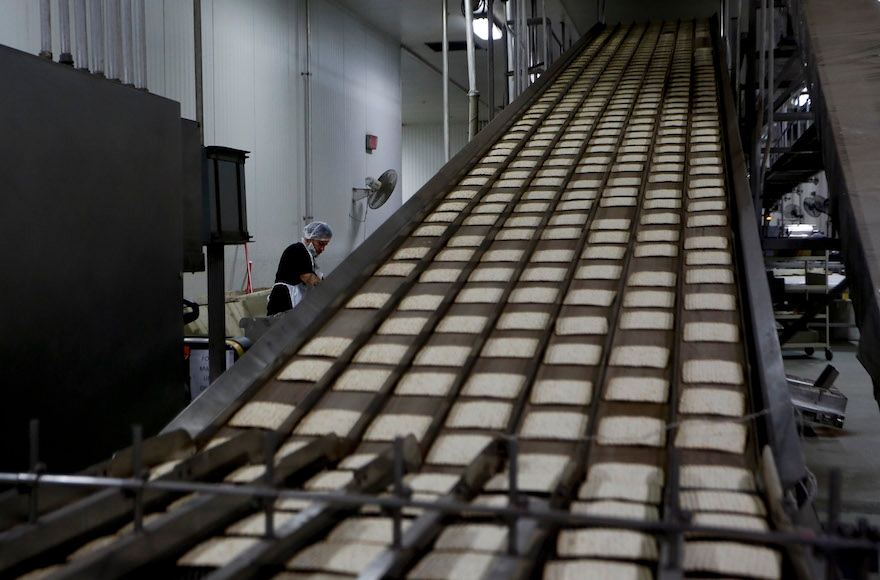(JTA) — Why are these macaroons different from all other macaroons? It’s a question that many American Jews may find themselves asking this Passover, and the answer will be: how they’re packaged.
That’s because Manischewitz, the iconic purveyor of kosher-for-Passover products, has shaken up its look, eschewing macaroon canisters for resealable bags, splashing the orange from its old logo all over its matzah boxes and covering its packaging with playful cartoon figures. It has won new fans in the process.
“I told my mom her Manischewitz box was yassified,” read one representative tweet about the rebrand, using a word that describes having undergone a makeover. (There’s an app for that.)
The rebrand — devised by the advertising agency Jones Knowles Ritchie, which has also worked on Uber, Adidas and Dunkin Donuts — has captured attention far beyond the Jewish shopper. New York Magazine has explored Manichewitz’s new look in its food vertical, and The Washington Post and The New York Times have given it the business-page treatment, with the latter even including a small photo spread and quoting prominent figures in the Jewish food world.
“My hope,” Amanda Dell, program director of the Jewish Food Society, told The New York Times, “is that this rebrand can instill a new sense of pride in Jewish food.”
But it’s not Jews the company is seeking to reach. The rebrand was part of “an effort to update the cultural relevancy with a younger Jewish audience as well as mainstream culturally curious audience,” Shani Seidman, CMO of Kayco, the parent company for Manischewitz, said in a statement released when the rebrand was announced in March.
The rebrand follows years of bumpy business for the company founded in the late 1800s by Rabbi Dov Behr Manischewitz, a matzah-making Eastern European immigrant in Cincinnati. The family business benefited from the advent of machine-made matzah, which Manischewitz took to a national market, where it found a willing audience of immigrants and their children hoping to recreate traditions from the old country in their new home.

Hot matzah traveling down a cooling belt at the Manischewitz facility in Newark, Feb, 4, 2014.
(Jeff Zelevansky/Getty Images)
As the American Jewish community grew into the second half of the 20th century, so did Manischewitz. But as the community grew less observant and less attached to traditional rituals and institutions, Manischewitz became associated with the old way of being Jewish in America. Jews stuck with the brand out of loyalty, tradition and, perhaps, a lack of less expensive options: The company was fined $1 million in 1991 for price-fixing.
The previous year, Manischewitz had exited the family’s control, having been taken private in a management buyout for $42.5 million. Pressure continued to mount: The kosher moscato Bartenura, for example, became a household name as the squared bottles of cloying Manischewitz wine sat on shelves. In 2019, the company sold to Kayco, its biggest competitor, for an undisclosed price.
Since then, the company’s biggest changes have been to its social media, where it has emerged as a consistently viral presence with a loyal following and a penchant for tapping into trends.
For the solar eclipse earlier this month, for example, the brand posted an image of a matzah ball with a corona familiar for anyone who has seen images of when the moon blocks the sun. The post got nearly 600 likes, whereas earlier posts before the rebrand rarely made it into the low three-digit range.
Faux Manischewitz foods (usually involving gefilte fish) shared to social media from the brand began appearing around the High Holidays in 2021, stoking the food fights that were until recently a hallmark of Jewish Twitter.
On the inventive menu: fake gefilte donuts and crypto gelt for Hanukkah; gefilte fish-topped pizza; Bamba gefilte puffs; gefilte dogs; gefilte pops; literal borscht belts; horseradish, matzah ball, and matzah pizza macaroons; and pumpkin spice gefilte fish.
The redesign aims to bring the social media vibes — if not the flavor profiles — offline and into the shopping carts and pantries of the brand’s consumers.
So far, it seems to have mostly hit the aesthetic mark, although whether that translates into sales figures remains to be seen. “The Manischewitz redesign is so cute,” one user of X, formerly Twitter, shared. “So excited to do my Passover shopping.”
“I have no visual sense so take this for what it’s worth, but I kind of love the Manischewitz rebrand,” wrote another user.
A few social media voices have expressed wistfulness about the old, more utilitarian design, which was on shelves for two decades.
“Something about the OG Manischewitz branding that made it homey and nostalgic…” tweeted Aleesa Kuznetsov, a Jewish reporter in Wisconsin. “It’s like rebranding a tradition. Sigh.”
For a company that has befuddled its followers with promises of hash brownie macaroons and matzah-patterned sneakers, the very real changes — which are set to be followed by new foods meant to be eaten all year long — have left some people scratching their heads.
Tweeted one user, “I thought the Manischewitz rebrand was an internet meme.”
JTA has documented Jewish history in real-time for over a century. Keep our journalism strong by joining us in supporting independent, award-winning reporting.






